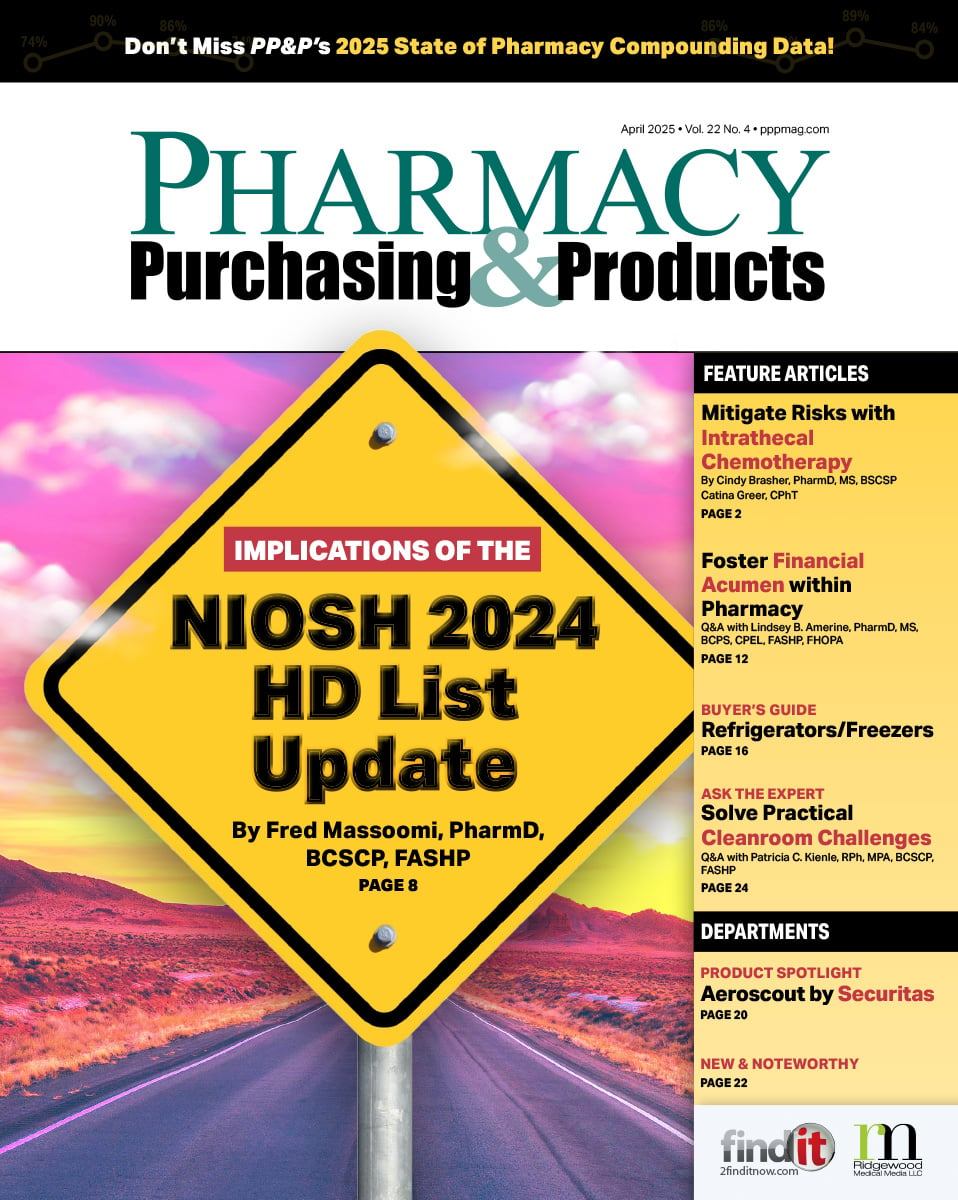- Show Menu
- Contact Us
- FAQs
- Reader Service
- Survey Data
- Survey Winners
- Testimonials
- Upcoming Events
- Webinars
- White Papers
Solving Packaging Challenges with Tabletop Unit Dose Packagers
One of the most popular and widespread process improvement trends of the last ten years has been the movement toward implementing point-of-care medication administration systems, the bedrock of which is a fully developed bar code inventory strategy. Reaching this goal, however, can be rife with challenges and requires fundamental process changes for pharmacy, nursing, and hospital information services. In addition to providing adequate access to emergent medications and a process for handling discontinued medications, it is key for pharmacy to develop a methodology for unit dose packaging all dosage forms. A successful bar code medication administration (BCMA) program requires that all medications dispensed by the pharmacy have a bar code that can be quickly and easily scanned into a facility’s pharmacy information system. Because oral solids and oral liquids comprise 65% to 70% of doses commonly dispensed by hospital pharmacies, implementing an oral solid packaging and labeling system is an ideal first step.
Tenet Healthcare Corporation comprises 49 acute care hospitals and 84 outpatient centers in 12 states, and in 2008 decided to seek out an in-house unit dose packaging process that could be implemented throughout the system. Having such a large group of hospitals under one umbrella has both positive and negative ramifications, but regardless, implementing technological changes throughout requires a keen sense of timing and consensus among all facilities, including many with disparate needs; a difficult proposition indeed. For the last two years, Tenet Healthcare has been in the process of rolling out BCMA throughout the system in conjunction with computerized prescriber order entry (CPOE) with a goal of introducing new, user-friendly technology and to being able to share health information among all of our facilities. With this mission in mind, a multidisciplinary team, dubbed the BAT (Bar coding At Tenet) team, was charged with identifying the features, functionality, and equipment types needed to facilitate BCMA throughout the Tenet hospital system. This team comprised representatives from nursing, pharmacy, purchasing, information services, quality, and nursing informatics staff. One of the primary goals of this team was to find a bar code packaging system for oral solids and liquids that would meet the needs of multiple different facilities.
Selecting Tabletop Bar Code Packaging Equipment
Most modern tabletop packagers employ a wheel design that sorts oral solids for filling, and all manufacturers use heat-sealing blisters. Some models use a straight-line feed process, a manual method that requires placing individual oral solids on a moving belt. As this would require constant interaction with the machine, our BAT team eliminated all straight-line packagers from consideration.
The ability of the machine and its software to automate as much of the packaging process—including data entry of the drug being packaged and verification of package accuracy via image and scan—was key to product selection. As such, a selection committee made up of seven directors of pharmacy from the BAT team was designated and charged with vetting the available tabletop unit dose packaging machine vendors at an ASHP Midyear clinical meeting. In order to codify the vetting process and results, we developed a selection sheet containing 27 elements of critical review (see Table 1). These sheets were then tabulated and the BAT team reviewed the results in order to make a final decision.

Click here to view a larger version of this Table
Determining Facility Needs and Capabilities
Due to the large number of facilities that would be affected by our final product choice, we needed to have a firm understanding of the packaging processes in place across the spectrum of Tenet facilities. Using free survey administration software, we gathered data from all 49 Tenet hospitals on the in-house packaging solutions in use, including the percentage of drugs being received in bar coded, unit dose packages from the manufacturer. We discovered that the majority of Tenet hospitals received an average of 74% of their drugs already in bar coded, unit dose packages. To handle the remaining oral solids that needed to be packaged in-house, most were employing manual packaging systems. The few hospitals that were using tabletop unit dose packagers at the time were running antiquated MS-DOS operating systems that had no scanning or visual verification capabilities.
Once we had a sense of the workload and level of sophistication throughout the Tenet Healthcare system, we had to make sure that each facility would be able to accommodate the upgrade to modern, automated tabletop unit dose packaging. Each pharmacy would have to provide the requisite FTEs to initiate packaging, have the physical space for the packaging equipment, and absorb the operational costs of the packaging system—supplies, training, maintenance, etc—moving forward. In order to help each facility understand what would be required, we determined the staffing resource requirement (for non-pediatric facilities) would be 5.6 hours of technician time per week (about one day) per 50 occupied beds, and about two hours per week of pharmacist time. Pediatric facilities, by contrast, require one technician to be assigned to this task daily just for oral syringe compounding, in addition to the oral solid packaging requirements.
Comparing High-volume vs Tabletop Unit Dose Packagers
For those facilities that are on or near the tipping point between high-volume unit dose packagers and tabletop unit dose packagers, there are several cost, time, and manpower issues to be reviewed. As with any broad technology type, the route you choose for in-house unit dose packaging should depend on your specific needs. For many high-census hospitals, a high-volume packager is absolutely necessary and justified to handle the large volume of repackaging. Nonetheless, it is key to look closely at the numbers to determine which technology is the best fit. High-volume canister packagers will require more time for installation and training and the space requirements are greater. Additional site preparation and annual maintenance costs can exceed $20,000 a year, and an overall level of pharmacy technology sophistication is also required, as these devices necessitate an interface if the goal is also to automate the refilling of automated dispensing cabinets, and some facilities use the packager to dispense first doses when interfaced with their pharmacy information system. The cost of enabling these interfaces is in addition to the cost of the equipment, which can be $220,000+ for a 300-canister unit. Based on these numbers, the BAT team recommended that Tenet facilities with an average census of 200 or more patients per day (or an average census of 150 per day with a cart fill distribution model), obtain a high-volume packager, as the cost and manpower would be justified. But as the majority of the hospitals in Tenet’s system fell below the threshold for high-volume automation, tabletop packaging was chosen as the main type of automation equipment to help facilitate our BCMA project.
The product we ultimately chose fit the most key features defined by our decision criteria. The machine uses an automated method whereby a bulk bottle of tablets or capsules can be placed on top of the unit and the packaging can be done without a technician having to push the tablets or capsules into the unit. Each unit also connects to First DataBank to update its drug database for new products and NDC updates, quarterly. A computer does need to be purchased to operationalize each unit, and a sturdy, level countertop or table with a height of 30 inches, plus room for the computer, is required for most packagers. Ultimately, the cost of each tabletop unit (including an autofeed mechanism) was approximately $25,000—far less than individual high-volume packagers—and required only about four hours each for setup and installation and two hours for training, per staff member. Annual maintenance costs are less than $2,000 per unit. At this point, there are no tabletop unit dose packagers that have the ability to interface directly to an automated dispensing system, but since the facilities that would most benefit from this technology are smaller-scale hospitals, this does not appear to be a major drawback.

Click here to view a larger version of this Table
Conclusion
Due to the ongoing emphasis on adopting point-of-care medication administration systems, vendors will continue to upgrade their systems, and more vendors will begin to supply packaging equipment. While some Tenet hospitals take advantage of third party, or outsourced, packaging vendors, this was not sufficient to meet the immediate daily needs of BCMA, due in part to the average seven-day turnaround time. We do encourage our member hospitals to purchase as many drugs as possible already in bar coded, unit dose form, but for some products this can prove cost prohibitive, especially certain oral liquids. There are many excellent solutions available in the market, including various labeling systems available to print bar coded labels for vials and syringes. Overall, BCMA processes have increased the need for technician FTEs to package medications in unit of use form. In our experience at Tenet, the use of automated tabletop unit dose packagers has allowed technicians to multitask during the packaging process, providing us with more flexibility to cover high-priority tasks. The ability to provide bold, easy-to-read two-dimensional bar codes and the capacity to package a product quickly with onsite or phone support have been beneficial in meeting the demand of providing all medications in bar coded, unit dose packages.
 Carla J. Maslakowski, MS, MEd, RPh, is the director of pharmacy implementations in the applied clinical informatics department at Tenet Healthcare Corporation. She received her bachelor of science in pharmacy degree from Creighton University in Omaha and her masters degree in education and computer science from Plymouth State University, Plymouth, New Hampshire. Carla also completed an ASHP hospital pharmacy residency and an MS in hospital pharmacy from the University of Kansas.
Carla J. Maslakowski, MS, MEd, RPh, is the director of pharmacy implementations in the applied clinical informatics department at Tenet Healthcare Corporation. She received her bachelor of science in pharmacy degree from Creighton University in Omaha and her masters degree in education and computer science from Plymouth State University, Plymouth, New Hampshire. Carla also completed an ASHP hospital pharmacy residency and an MS in hospital pharmacy from the University of Kansas.
Minimum Requirements for Oral Solid Unit Dose Packagers
- Capable of producing labels with Tallman lettering
- Automated packaging ability
- Minimum speed of 60 pkgs/min
- Ability to scan bulk drug bottles to auto-populate database with relevant information
- Ability to package using both one- and two-dimensional bar codes
- Attached screen displays image (from a drug reference database such as First DataBank or Alchemy) of drug being packaged after bulk bottle is scanned
- Ability to update packager’s reference database with new drug and NDC information
- Ability to scan each finished unit dose product to verify packaging quality and accuracy
- Ability to generate reports to satisfy state board of pharmacy requirements
Like what you've read? Please log in or create a free account to enjoy more of what www.pppmag.com has to offer.








